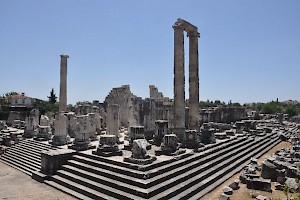Didyma
Q671358Didyma: oracle of Apollo near Miletus, also known as Branchidae.

Didyma was the oracular shrine of Apollo at Miletus, to which it was connected by the "Sacred Road". Its priests were the Branchidae. The existence of the sanctuary antedates the Greek colonization of Ionia, and in historical times, people thought that the sacrifices were very unGreek. The name "Didyma", for example, is Anatolian in origin, although the Greeks were reminded of their word didymoi, "twins" (i.e., Apollo and Artemis.)
The temple building itself was founded at the end of the eighth century. A century and a half later, it was well-known throughout the ancient world. According to Herodotus of Halicarnassus, pharaoh Necho II sent presents.note Half a century later, Croesus of Lydia did the same.note

After the Persians had defeated the Ionian Greeks at Lade, they sacked Miletus and destroyed Didyma; part of the booty was brought to Susa, where it was discovered by archaeologists. The Branchidae were deported to the east; the report that Alexander the Great met and killed their descendants in Sogdia may or may not be correct. It is remarkable that later, it was claimed that the Persian king Darius I the Great, who had been responsible for the sack, had also awarded privileges to Didyma.note

It was only after Alexander had defeated the Persians, that the oracle spoke again. If we are to believe the Macedonian propaganda, Apollo's first announcement was that Alexander was the son of a god indeed.
Alexander ordered the reconstruction of the temple, but it was left to Seleucus I Nicator, the founder of the Seleucid empire, to make a beginning with the project. He cannot have done this before 300, after the battle of Ipsus in which he conquered this part of Alexander's empire.

His architects were Daphnis and Paionios. The temple was designed to measure 109 by 51 meter, but remained unfinished. A large hall that was to be the heart of the temple (the adyton), never had a roof, which meant that a small sanctuary was built inside the roofless hall. The adyton now became some sort of open courtyard with disproportionally high outer walls, surrounding a little temple (naiskos).
Several phases of rebuilding can be indicated. The beautifully decorated columns were finished in 37 CE and the gorgons on the cornice of the temple date back to the second century CE.
The altar is a bit of a problem: the circular structure in front of the temple is on the right place, but appears to be too small. A plausible alternative is that the altar was a bit to the north, where a mosque stands on an old church, which appears to be founded on a structure from Antiquity. From an inscription that can be dated to the reign of Justinian, we can deduce that Didyma was still a cultic site in the sixth century.
South of Didyma was the port of Panormus, where the pilgrims disembarked.



























